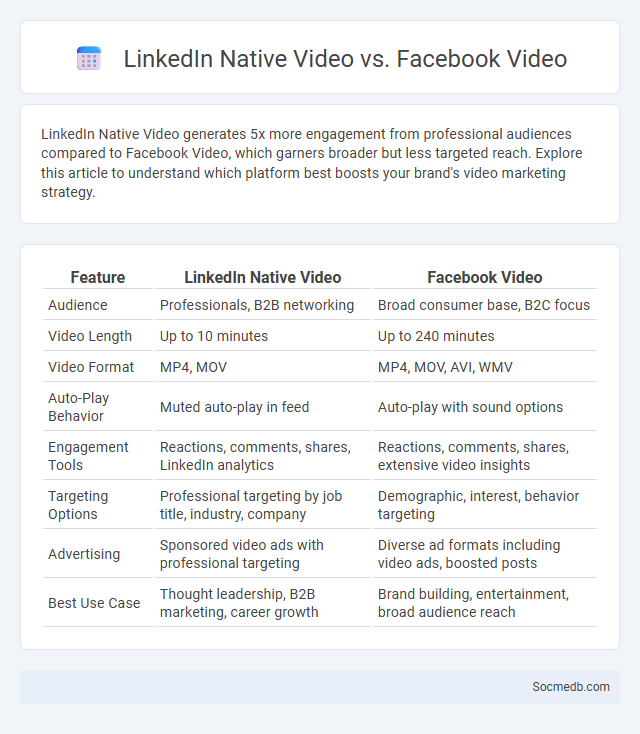
Photo illustration: LinkedIn Native Video vs Facebook Video
LinkedIn Native Video generates 5x more engagement from professional audiences compared to Facebook Video, which garners broader but less targeted reach. Explore this article to understand which platform best boosts your brand's video marketing strategy.
Table of Comparison
| Feature | LinkedIn Native Video | Facebook Video |
|---|---|---|
| Audience | Professionals, B2B networking | Broad consumer base, B2C focus |
| Video Length | Up to 10 minutes | Up to 240 minutes |
| Video Format | MP4, MOV | MP4, MOV, AVI, WMV |
| Auto-Play Behavior | Muted auto-play in feed | Auto-play with sound options |
| Engagement Tools | Reactions, comments, shares, LinkedIn analytics | Reactions, comments, shares, extensive video insights |
| Targeting Options | Professional targeting by job title, industry, company | Demographic, interest, behavior targeting |
| Advertising | Sponsored video ads with professional targeting | Diverse ad formats including video ads, boosted posts |
| Best Use Case | Thought leadership, B2B marketing, career growth | Brand building, entertainment, broad audience reach |
Introduction to Native Video Platforms
Native video platforms integrate video content directly within social media networks, enabling seamless sharing and engagement without redirecting users to external sites. These platforms, including Instagram Reels, TikTok, and Facebook Watch, optimize video formats for mobile consumption and algorithm-driven discovery to boost your content's visibility. Leveraging native video enhances user interaction, increases organic reach, and drives higher retention compared to traditional video posting methods.
What is LinkedIn Native Video?
LinkedIn Native Video refers to videos uploaded directly to the LinkedIn platform, enabling users to share professional content without linking to external sites. This feature enhances engagement by leveraging LinkedIn's algorithm to prioritize video content, resulting in higher visibility and interaction from networks of professionals, recruiters, and companies. Native videos can include company updates, product demonstrations, webinars, and thought leadership, optimizing LinkedIn's role in B2B marketing and personal branding strategies.
Understanding Facebook Native Video
Facebook Native Video maximizes engagement by leveraging the platform's algorithm to prioritize in-feed playback and auto-play features, resulting in higher organic reach compared to external video links. Native videos support HD resolution, captions, and interactive elements like polls and call-to-action buttons, enhancing viewer retention and interaction. Insights from Facebook Analytics provide detailed metrics such as watch time, audience demographics, and peak engagement times, enabling effective content optimization.
Unique Features of Native Video Across Platforms
Native video on social media platforms offers unique features like seamless autoplay, optimized aspect ratios, and enhanced engagement tools that boost your content's visibility and interaction rates. Platforms such as Facebook, Instagram, and TikTok provide tailored editing tools, captions, and interactive stickers that capitalize on native formats to capture audience attention more effectively. Leveraging these native video strengths ensures your content performs better in algorithmic ranking and audience retention compared to shared or embedded videos.
Video Algorithms: LinkedIn vs Facebook
LinkedIn's video algorithm prioritizes professional content, engagement from connections, and relevance to your industry, promoting videos that foster networking and career growth. Facebook's video algorithm emphasizes watch time, user interaction, and viral potential, often surfacing entertaining or trending videos to keep users engaged longer. Understanding these differences helps you tailor your video strategy to maximize reach and impact on each platform.
Audience Engagement: Platform Comparisons
Audience engagement varies significantly across social media platforms, with Instagram and TikTok leading in visual content interaction, while Twitter excels in real-time conversation and trending topics. Facebook offers robust community-building tools ideal for long-form content and targeted advertising, whereas LinkedIn is unmatched for professional networking and B2B engagement. Understanding these platform-specific dynamics can enhance your content strategy and maximize your audience reach effectively.
Video Formats and Upload Requirements
Video formats such as MP4, MOV, and AVI are widely supported across popular social media platforms including Facebook, Instagram, and TikTok, with MP4 being the most universally accepted for high-quality playback. Your video uploads must adhere to platform-specific requirements, including aspect ratios like 1:1 for Instagram feed, 9:16 for TikTok stories, maximum file sizes usually capped at 4GB, and resolutions ranging from 720p to 1080p to ensure optimal viewer experience. Understanding these technical specifications enhances your video content's visibility and engagement by ensuring smooth delivery without compression loss or playback errors.
Performance Analytics for Native Video
Performance analytics for native video on social media platforms provide detailed insights into viewer engagement, including watch time, completion rates, and interaction metrics such as likes, shares, and comments. These analytics help marketers optimize video content by identifying peak audience retention points and adjusting delivery strategies to maximize reach and impact. Utilizing platform-specific tools like Facebook Insights, Instagram Analytics, and YouTube Studio enhances the precision of native video performance tracking and content optimization.
Best Practices for Each Platform
Optimizing your social media strategy requires understanding each platform's unique best practices to maximize engagement and reach. On Instagram, prioritize high-quality visuals and use relevant hashtags to boost discoverability, while on Twitter, concise and timely updates with trending hashtags garner the most interactions. For LinkedIn, focus on professional content that encourages thoughtful discussion, and on Facebook, mix multimedia posts with community engagement to foster loyalty.
Choosing the Right Platform for Your Video Content
Selecting the ideal social media platform for video content depends on target audience demographics, video format, and engagement goals. Instagram excels in short-form, visually engaging videos appealing to younger users, while YouTube offers extensive reach for long-form, high-quality content across diverse niches. TikTok is optimal for viral, short videos with trending audio, making it essential for brands aiming to boost visibility through creative challenges and user interaction.
 socmedb.com
socmedb.com